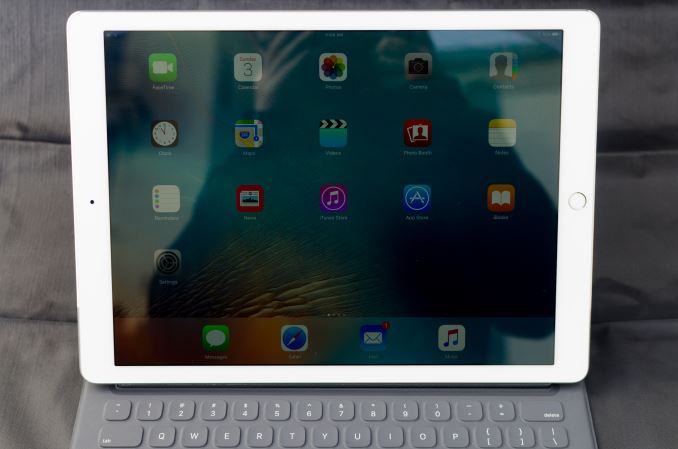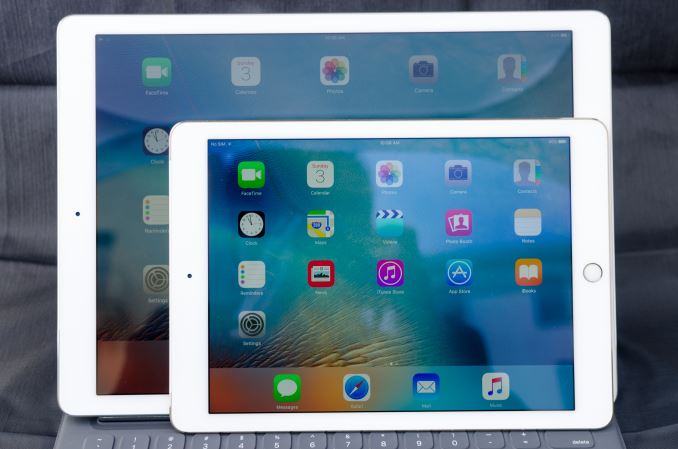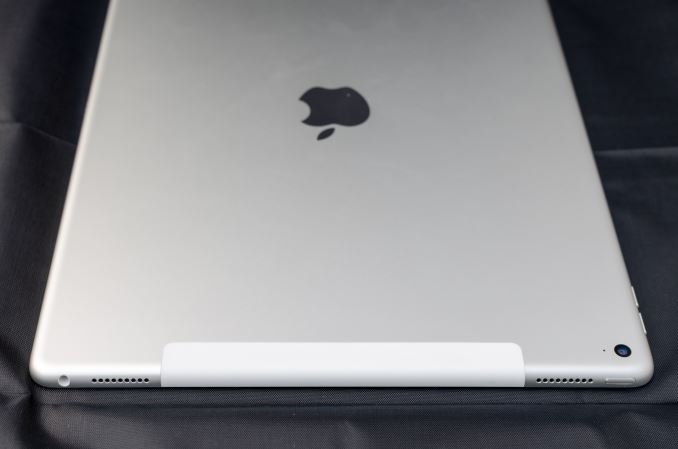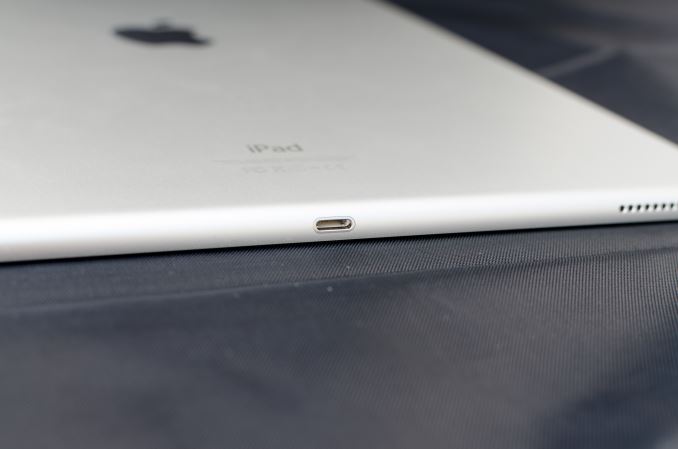The Apple iPad Pro Review
by Ryan Smith, Joshua Ho & Brandon Chester on January 22, 2016 8:10 AM EST
At this point it probably isn’t a secret that tablet sales have leveled off, and in some cases they have declined. Pretty much anywhere you care to look you’ll see evidence that the tablet market just isn’t as strong as it once was. It’s undeniable that touch-only tablets have utility, but it seems that the broader market has been rather lukewarm about tablets. I suspect at least part of the problem here is that the rise of the phablet has supplanted small tablets. Large tablets are nice to have, but almost feel like a luxury good when they’re about as portable as an ultrabook. While a compact laptop can’t easily be used while standing, or any number of other situations where a tablet is going to be better, a compact laptop can do pretty much anything a touch-only tablet can. A laptop is also going to be clearly superior for a significant number of cases, such as typing or precise pointing.
As a result, large touch-only tablets feel like they’ve been limited to home use as a computer away from the computer. Tablets are great when you’re on the couch or in bed, but once you get to this point there are some obvious questions as to whether it makes sense to drop $500+ USD on a tablet that seems to have relatively limited utility. The Surface lineup has been showing signs of growth, but in general the Surface is more of a mix between laptop and tablet rather than a tablet. I would argue that given the OS and overall design that the Surface and Surface Pro are really more laptop than tablet, even if at the hardware level the Surface Pro 4 and Surface 3 are basically tablets with kickstands and keyboard covers.
If you’re guessing that this means Apple has had some issues with growing sales of their iPad lineup, you’d be right. From my first experiences with the iPad 3, I was impressed with the improved user experience for things like web browsing and other smartphone tasks, but I never really felt like it made enough sense to get one for myself. The iPad Air 2 was once again impressive and I felt like I could recommend it to other people that wanted a tablet, but I personally struggled to come up with a reason why I would buy it.
This brings us to the iPad Pro. This is probably the first time Apple has seriously deviated from traditional iPad launches, putting together a tablet built for (limited) productivity and content creation rather than just simple content consumption, creating what's arguably the iPad answer to the Surface Pro. To accomplish this, Apple has increased the display size to something closer to that of a laptop, and we see the addition of a stylus and a keyboard cover for additional precision inputs. Of course, under the hood there have been a lot of changes as well, so the usual spec sheet can be found below to summarize those changes.
| Apple iPad Air 2 | Apple iPad Pro | |
| SoC | Apple A8X 3 x Apple Typhoon @ 1.5GHz |
Apple A9X 2 x Apple Twister @ 2.2GHz |
| GPU | PowerVR 8 Cluster Series6XT (Apple GXA6850) |
PowerVR 12 Cluster Series7XT |
| RAM | 2GB LPDDR3 | 4GB LPDDR4 |
| NAND | 16/64/128GB | 32/128GB |
| Display | 9.7" 2048x1536 IPS LCD | 12.9" 2732x2048 IPS LCD |
| Size and Mass | 240 x 169.5 x 6.1mm 437g WiFi, 444g LTE |
305.7 x 220.6 x 6.9 mm 713g WiFi, 723g LTE |
| Camera | 8MP Rear-Facing, f/2.4, 1.1 micron, 1.2MP Front-Facing, f/2.2 | |
| Battery | 27.3Wh | 38.5Wh |
| Launch OS | iOS 8 | iOS 9 |
| Cellular Connectivity | MDM9x25 Category 4 LTE + GPS/GNSS in Cellular SKU | |
| Other Connectivity | 2x2 802.11a/b/g/n/ac + BT 4.2, Apple Lightning | |
| SIM | Optional NanoSIM | |
| Price | $499/599/699 16/64/128GB | $799/949/1079 32/128GB/128GB LTE |
At a high level, the iPad Pro gains a larger display with a higher resolution, more memory, a new SoC, and a larger battery to compensate for the change in display size. In addition to these changes, the iPad Pro also brings noticeable changes to the speakers, with an increase to four speakers which allow the iPad Pro to compensate for device orientation when projecting stereo audio.
Design
The most immediate change that you can see in the iPad Pro is the sheer size. The 12.9” display of the iPad Pro basically makes it feel like you’re carrying a laptop around. I would argue that this doesn’t actually affect the portability of the iPad Pro, but this is mostly because the iPad Air 2 was something that I only carried in a backpack to begin with. People carrying their tablets in a small bag, purse, or even just in their hands will notice the difference, so the change in size might be more or less noticeable depending upon how you carry things around.
The increase in size does affect weight. After significant use, I honestly don’t think the mass is a significant issue. It does feel heavier than the iPad Air 2, but the mass distribution is such that there isn’t a ton of battery hanging out at the edges of the device where it’ll affect the moment of inertia. This does raise the question of whether Apple included enough battery for sufficient battery life, but that’s a question best left for the rest of the review.
In terms of design, the iPad Pro is rather unremarkable if you’ve ever seen an iPad Air before; it is for all intents and purposes a bigger iPad Air. On the front, the display dominates, with some bezels on the sides and top. The top has the front-facing camera, and the bottom has the home button with TouchID.
Looking at the sides of the tablet, the top edge has the power button and 3.5mm port, along with two of the four speakers. The right edge has the volume buttons, and the bottom edge has the Lightning port and the other two speakers. The left edge is mostly empty, but contains the Smart Connector for the Smart Keyboard and similar accessories.
The back of the tablet is mostly unremarkable as well. For the LTE model, an RF window is visible on the top of the device to allow LTE and other connectivity to function. For the WiFi variants, it looks like the bottom display bezel and the bottom two speakers are the RF windows, so there aren’t any visible areas that indicate where the WiFi antennas are.
Overall, the iPad Pro feels like an iPad, with nothing all that remarkable beyond its size which is carried well. I never really noticed the mass or size of the iPad Pro even if it is clearly larger and heavier than the iPad Air 2. I also didn’t notice any issues with the back cover flexing, but given enough pressure on the back cover pretty much any device this large will see some screen distortion or bending. The iPad Pro does technically regress in thickness compared to the iPad Air 2, but I never noticed the difference in practice, especially when the larger display is really what matters more.
















408 Comments
View All Comments
MathieuLF - Monday, January 25, 2016 - link
Obviously you don't actually work in a real office where they require lots of specialized software. What's the point of having one device to complement another? That's a waste of resources.LostAlone - Tuesday, January 26, 2016 - link
Totally agree. For a device to really be useful on a professional level then it needs to be something that is useful all the time, not just when it suits it. If you already wanted a tablet for professional stuff to begin with (a pretty shaky assumption since pro users tend to be working in one place where proper keyboard and mouse are usable) then you need a tablet that can be the only device you need to work on. You need something that you can put in your bag and know that whenever you arrive somewhere you are going to have every single tool you need. And that is not the iPad Pro. It's not even close to replacing an existing laptop. It's certainly very sexy and shiny and the big screen makes it great for reading comics and watching videos on the train but it's not a work device. It's simply not. Even in the only field where it might have claim to being 'pro' (drawing) it's not. It's FAR worse than a proper Wacom tablet because the software is so hugely lacking.It's an iPad dressed up like a grown up device laying in the shadow of actual professional grade devices like the Surface Pro. You get a Surface then you can use it 24/7 for work. You can buy a dock for it and use it as your primary computer. You can get every single piece of software on your desktop plus anything your employer needs and it's easy for your work sysadmins to include it in their network because it's just another Windows PC. Just dumb stuff like iPads refusing to print on networked printers (which happens ALL the time by the way) exclude it from consideration in a professional space. It's a great device for traditional tablet fare but it's not a pro device.
Constructor - Tuesday, January 26, 2016 - link
Your straw man scenarios are just that. In reality most users don't need every last exotic niche feature of any given dinosaur desktop software as a praeconditio sine qua non.Which you also might be able to deduce from the fact that most of those features had not been present on these desktop applications either when "everybody" nevertheless used them professionally even so.
In real life the physical flexibility and mobility of an iPad will often trump exotic software features (most bread-and-butter stuff is very much supported on iOS anyway) where the circumstances simply call for it.
Actual professionals have always made the difference notably by finding pragmatic ways to make the best use of the actual tools at hand instead of just whining about theoretical scenarios from their parents' basements for sheer lack of competence and imagination.
kunalnanda - Wednesday, January 27, 2016 - link
Just saying, but most office workers use a LOT more than simply notetaking, email, wordprocessor and calendar.Demigod79 - Friday, January 22, 2016 - link
Software companies only create crippled, lesser versions of their software because of the mobile interface. Products like the iPad are primarily touch-based devices so apps must be simplified for touch. Although the iPad supports keyboard input (and have for years) you cannot navigate around the OS using the keys, keyboard shortcuts are few and far between and and it still has touch features like autocorrect (and of course the iPad does not support a trackpad or mouse so you must necessarily touch the screen). The iPad Pro does not change this at all so there's no reason why software companies should bring their full productivity suite to this device. By comparison, PC software developers can rely on users having a keyboard and mouse (and now touchscreens as well for laptops and hybrids) so they can create complex, full-featured software. This is the primary difference between mobile and desktop apps. Just like FPS games must be watered down and simplified to make them playable with a touchscreen, productivity apps must also be watered down to be usable. No amount of processing power will change this, and unless the iPad Pro supports additional input devices (at the very least a mouse or trackpad) it will remain largely a consumption device.gistya - Sunday, January 24, 2016 - link
This is just wrong. There are many fully-fledged applications available on iPad. It comes with a decent office suite, plus Google's is free for it as well. I haven't touched MS Word in a couple of years, and when I do it seems like a step backwards in time to a former, crappier era of bloatware.Sure, I still use Photoshop and Maya and Pro Tools on my Mac, but guess what? iPad has been part of my professional workflow for four years now, and I would not go back.
Ask yourself: is a secondary monitor a "professional tool"? Heck yes. What about a third or fourth? What if it fits in your hand, runs on batteries, and has its own OS? Now you cannot find a professional use?
Give me a break. People who are not closed-minded, negative dolts already bought millions of iPads and will keep buying them because of how freaking useful they are, professionally and non-professionally. They will only keep getting more useful as time goes on.
The main legit critique I've heard is a lack of availability for accessories but that's a production issue, not a product issue. iOS 9 has been out for only a few months and the iPad Pro much less than that... companies have to actually have the device in-hand before they can test and develop on it. Check back in another year or two if it's not up to speed for you yet though.
That's what I did, waited for iPad 3, iPhone 3gs before I felt they were ready enough. 3gs for its day was by far the best thing out, so was the 4s. I don't think the iPad Pro is nearly as far back as the iPad 1 or iPhone 1 were when they launched but give it time...
xthetenth - Monday, January 25, 2016 - link
If you consider features to be bloat, I guess you could say that the iPad has full-fledged applications. It's not true, but you could say it. Actually trying to do even reasonably basic tasks in google sheets is horrifying next to desktop Excel. Things like straightforward conditional formatting, pivot tables, the ability to dynamically order the contents of a table and so on might strike you as bloat but they're the foundation of the workflows of people who make the program the cornerstone of their job. An extra monitor is a much better professional tool if it doesn't have its own special snowflake OS with different limitations and way of moving data.Relic74 - Saturday, February 27, 2016 - link
The fffice suits available aren't fully fledged applications, they are still just mobile apps. I can't open 80% of my Excel sheets on the iPad Pro simply because it doesn't support Macros. Visual Basic and Databases. Stop trying to convince everyone that the iPad Pro is a laptop replacement, it's not. It's just a bigger iPad, that's all. Which is fine and has it's uses, but the only people who would use the iPad Pro as an actual computer are the same ones who could get by using a ChromeBook. A professional person could use the iPad Pro, yes but they would have a focused purpose, which means only a few specific apps, the rest of time would be spent on a desktop or laptop computer. It's a secondary device.Relic74 - Saturday, February 27, 2016 - link
Their not crippled, just mobile versions and they have their uses. The problem I have with these comments is when someone says that the iPad Pro is immensely better than the Surface Pro 4. These are completely different devices intended for completely different tasks. These comparisons honestly need to stop, one doesn't buy a Surface Pro 4 to use as a tablet and vice versa. The iPad Pro is a content consumption device first and foremost. Yes there are some productivity apps and certain professions like a musician or an artist could take advantage of the iPad Pro's capabilities however it is not and I cannot stress this enough, is not a laptop replacement . Those that can use the iPad Pro as a laptop are the same types of people who can just as easily get by using a ChromeBook. The iPad Pro is a secondary device where as the Surface Pro is a primary device.IOS is just to limited in it's capabilities to be even considered as a standalone professional device. No, an Architect would not use the iPad Pro to design an house with, the Architect might use one to show off the plans to a client, mark down corrections with the Pencil. No, a programmer would not use the iPad Pro to develope on, he however might use one to create an outline of what needs to be done or even as a second monitor for his laptop. No, a musician would not use one to create his album with, he might use one as the brain for one of his synthesizer, a recording device, instrument, etc. it's a companion device, it's an iPad, nothing wrong with that but stop trying to convince everyone that it's some super computer with fantasy powers. Just the file system issue alone should be enough to tell you that the iPad Pro isn't really meant for connect creation.
FunBunny2 - Friday, January 22, 2016 - link
-- Modern software is very bloated memory consumption wise, especially software relying on managed languages, the latter are also significantly slower in terms of performance than languages like C or C++.well, that was true back in the days of DOS. since windoze, 80% (or thereabouts) of programs just call windoze syscalls, which is largely C++.